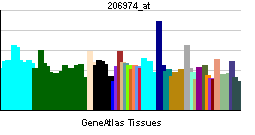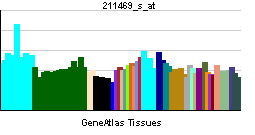CXCR6
| Chemokine (C-X-C motif) receptor 6 | |||||||||||
|---|---|---|---|---|---|---|---|---|---|---|---|
| Identifiers | |||||||||||
| Symbols | CXCR6 ; BONZO; CD186; STRL33; TYMSTR | ||||||||||
| External IDs | Template:OMIM5 Template:MGI HomoloGene: 38197 | ||||||||||
| |||||||||||
| RNA expression pattern | |||||||||||
 | |||||||||||
 | |||||||||||
| More reference expression data | |||||||||||
| Orthologs | |||||||||||
| Template:GNF Ortholog box | |||||||||||
| Species | Human | Mouse | |||||||||
| Entrez | n/a | n/a | |||||||||
| Ensembl | n/a | n/a | |||||||||
| UniProt | n/a | n/a | |||||||||
| RefSeq (mRNA) | n/a | n/a | |||||||||
| RefSeq (protein) | n/a | n/a | |||||||||
| Location (UCSC) | n/a | n/a | |||||||||
| PubMed search | n/a | n/a | |||||||||
Chemokine (C-X-C motif) receptor 6, also known as CXCR6, is a human gene.[1]
CXCR6 has also recently been designated CD186 (cluster of differentiation 186).
References
Further reading
- Ruibal-Ares BH, Belmonte L, Baré PC; et al. (2004). "HIV-1 infection and chemokine receptor modulation". Curr. HIV Res. 2 (1): 39–50. PMID 15053339.
- Liao F, Alkhatib G, Peden KW; et al. (1997). "STRL33, A novel chemokine receptor-like protein, functions as a fusion cofactor for both macrophage-tropic and T cell line-tropic HIV-1". J. Exp. Med. 185 (11): 2015–23. PMID 9166430.
- Deng HK, Unutmaz D, KewalRamani VN, Littman DR (1997). "Expression cloning of new receptors used by simian and human immunodeficiency viruses". Nature. 388 (6639): 296–300. doi:10.1038/40894. PMID 9230441.
- Loetscher M, Amara A, Oberlin E; et al. (1998). "TYMSTR, a putative chemokine receptor selectively expressed in activated T cells, exhibits HIV-1 coreceptor function". Curr. Biol. 7 (9): 652–60. PMID 9285716.
- Hoffman TL, Stephens EB, Narayan O, Doms RW (1998). "HIV type I envelope determinants for use of the CCR2b, CCR3, STRL33, and APJ coreceptors". Proc. Natl. Acad. Sci. U.S.A. 95 (19): 11360–5. PMID 9736741.
- Schramm B, Penn ML, Speck RF; et al. (2000). "Viral entry through CXCR4 is a pathogenic factor and therapeutic target in human immunodeficiency virus type 1 disease". J. Virol. 74 (1): 184–92. PMID 10590105.
- Tscherning-Casper C, Vödrös D, Menu E; et al. (2000). "Coreceptor usage of HIV-1 isolates representing different genetic subtypes obtained from pregnant Cameroonian women. European Network for In Utero Transmission of HIV-1". J. Acquir. Immune Defic. Syndr. 24 (1): 1–9. PMID 10877489.
- Ignatius R, Wei Y, Beaulieu S; et al. (2000). "The immunodeficiency virus coreceptor, Bonzo/STRL33/TYMSTR, is expressed by macaque and human skin- and blood-derived dendritic cells". AIDS Res. Hum. Retroviruses. 16 (11): 1055–9. doi:10.1089/08892220050075318. PMID 10933620.
- Unutmaz D, Xiang W, Sunshine MJ; et al. (2000). "The primate lentiviral receptor Bonzo/STRL33 is coordinately regulated with CCR5 and its expression pattern is conserved between human and mouse". J. Immunol. 165 (6): 3284–92. PMID 10975845.
- Matloubian M, David A, Engel S; et al. (2001). "A transmembrane CXC chemokine is a ligand for HIV-coreceptor Bonzo". Nat. Immunol. 1 (4): 298–304. doi:10.1038/79738. PMID 11017100.
- Wilbanks A, Zondlo SC, Murphy K; et al. (2001). "Expression cloning of the STRL33/BONZO/TYMSTRligand reveals elements of CC, CXC, and CX3C chemokines". J. Immunol. 166 (8): 5145–54. PMID 11290797.
- Lee B, Leslie G, Soilleux E; et al. (2001). "cis Expression of DC-SIGN allows for more efficient entry of human and simian immunodeficiency viruses via CD4 and a coreceptor". J. Virol. 75 (24): 12028–38. doi:10.1128/JVI.75.24.12028-12038.2001. PMID 11711593.
- Calabresi PA, Yun SH, Allie R, Whartenby KA (2002). "Chemokine receptor expression on MBP-reactive T cells: CXCR6 is a marker of IFNgamma-producing effector cells". J. Neuroimmunol. 127 (1–2): 96–105. PMID 12044980.
- Kim CH, Johnston B, Butcher EC (2002). "Trafficking machinery of NKT cells: shared and differential chemokine receptor expression among V alpha 24(+)V beta 11(+) NKT cell subsets with distinct cytokine-producing capacity". Blood. 100 (1): 11–6. doi:10.1182/blood-2001-12-0196. PMID 12070001.
- Strausberg RL, Feingold EA, Grouse LH; et al. (2003). "Generation and initial analysis of more than 15,000 full-length human and mouse cDNA sequences". Proc. Natl. Acad. Sci. U.S.A. 99 (26): 16899–903. doi:10.1073/pnas.242603899. PMID 12477932.
- Duggal P, An P, Beaty TH; et al. (2004). "Genetic influence of CXCR6 chemokine receptor alleles on PCP-mediated AIDS progression among African Americans". Genes Immun. 4 (4): 245–50. doi:10.1038/sj.gene.6363950. PMID 12761559.
- Koprak S, Matheravidathu S, Springer M; et al. (2003). "Down-regulation of cell surface CXCR6 expression during T cell activation is predominantly mediated by calcineurin". Cell. Immunol. 223 (1): 1–12. PMID 12914753.
- Shimaoka T, Nakayama T, Fukumoto N; et al. (2004). "Cell surface-anchored SR-PSOX/CXC chemokine ligand 16 mediates firm adhesion of CXC chemokine receptor 6-expressing cells". J. Leukoc. Biol. 75 (2): 267–74. doi:10.1189/jlb.1003465. PMID 14634054.
- Gerhard DS, Wagner L, Feingold EA; et al. (2004). "The status, quality, and expansion of the NIH full-length cDNA project: the Mammalian Gene Collection (MGC)". Genome Res. 14 (10B): 2121–7. doi:10.1101/gr.2596504. PMID 15489334.
This article incorporates text from the United States National Library of Medicine, which is in the public domain.
| Stub icon | This membrane protein–related article is a stub. You can help Wikipedia by expanding it. |